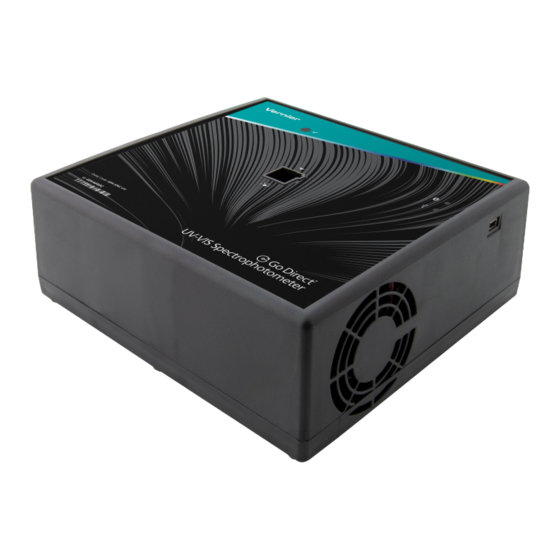
Table of Contents
Advertisement
Quick Links
®
Go Direct
UV-VIS
Spectrophotometer
(Order Code GDX-SPEC-UV)
The Go Direct UV-VIS Spectrophotometer is a small,
lightweight ultraviolet and visible light spectrophotometer.
Note: Vernier products are designed for educational use. Our products are not
designed nor are they recommended for any industrial, medical, or commercial
process such as life support, patient diagnosis, control of a manufacturing
process, or industrial testing of any kind.
What's Included
Go Direct UV-VIS Spectrophotometer
l
AC Power Supply
l
Starna quartz cuvettes (2)
l
Mini USB cable
l
USB Power Adapter
l
Compatible Software and Interfaces
See
www.vernier.com/manuals/gdx-spec-uv
compatible with the Go Direct UV-VIS Spectrophotometer.
Getting Started
Please see the following link for platform-specific connection information:
www.vernier.com/start/gdx-spec-uv
Bluetooth Connection
1. Install Vernier Spectral Analysis
your computer, Chromebook™, or
mobile device. See
www.vernier.com/spectral-analysis
for Spectral Analysis availability.
2. Connect the AC Power Supply to the
spectrophotometer. This supplies
power to the lamp. Turn the power
switch to the ON position. Wait for
the lamp indicator LED to remain
green.
3. To power the Bluetooth radio,
connect the spectrometer to the USB
power adapter or to a powered USB
®
hub. The Bluetooth
LED will blink.
Note: Do not plug the USB into a
computer USB port to run with
Bluetooth wireless technology.
for a list of interfaces and software
USB Connection
®
on
1. Connect the AC Power Supply to
the spectrophotometer. Turn the
power switch to the ON position.
Wait for the lamp indicator LED to
remain green.
2. Connect the spectrometer to the
USB port.
3. Launch the software. Options
include
Computer: Spectral Analysis or
l
Logger Pro 3
Chromebook: Spectral Analysis
l
LabQuest: LabQuest App
l
Mobile Device: Spectral Analysis
l
4. The software will identify the
spectrometer and enter data-
collection mode. You are now
4. Launch Spectral Analysis.
5. Click or tap Connect a Spectrometer.
Select your Go Direct UV-VIS
Spectrophotometer from the list of
Discovered Wireless Devices. Your
spectrometer's ID is located near the
barcode on the label. The Bluetooth
LED on the sensor will now glow
blue (no longer flashing).
6. Click or tap Done to enter data-
collection mode. You are now ready
to continue your experiment.
Powering the Spectrometer
Turning on the
Connect to AC power. Turn the power switch on. Green LED
spectrometer
indicator next to Power icon is solid when unit is ready to use.
If indicator light turns red, disconnect all power, wait one full
minute, and attempt again.
Turning off
Turn the power switch to the off position. The lamp will turn
the
off and the fan will continue to run to cool the electronics for
spectrometer
several more minutes. Wait until this is complete before dis-
connecting AC power.
Connecting the Spectrometer
See the following link for up-to-date connection information:
www.vernier.com/start/gdx-spec-uv
Connecting via Bluetooth
Ready to connect
Connected
Connecting via USB
Connected
1
ready to continue your experiment.
Connect to AC power. Turn the power switch on.
To power the Bluetooth radio, connect the spec-
trometer to the USB power adapter or to a
powered USB hub. Blue LED next to Bluetooth
icon flashes when sensor is ready to connect.
Blue LED next to Bluetooth icon is solid when
sensor is connected via Bluetooth wireless tech-
nology.
LED next to Bluetooth icon is off. LED next to
power is solid green. LED next to USB icon is
solid green.
Advertisement
Table of Contents

Summary of Contents for Vernier Go Direct UV-VIS
- Page 1 The Bluetooth LED on the sensor will now glow Note: Vernier products are designed for educational use. Our products are not blue (no longer flashing). designed nor are they recommended for any industrial, medical, or commercial 6.
- Page 2 LED or a gas discharge tube. To do so, you will need to 7. To see the best fit line equation for the standard solutions, click or tap Graph purchase the Vernier Optical Fiber (order code: VSP-FIBER). Tools, select Apply Curve Fit, and choose Linear. Click or tap Apply.
- Page 3 3. Select the appropriate Emissions experiment from the listed options and follow 4. To store the spectrum data, tap on the file cabinet icon in the upper right of the prompts in the app. Intensity is a relative measure with a range of 0–1. your screen.
- Page 4 2. Aim the tip of the optical fiber at a light source. Start data collection. Tap the Calibrate (Optional if Measuring Intensity) 1. To calibrate the Spectrophotometer, choose Calibrate ► Spectrophotometer Stop button to end data collection. Note: The Spectrophotometer is not from the Experiment menu.
- Page 5 9. If doing Beer’s law to determine the concentration of an unknown, place the unknown sample in the cuvette holder. Choose Interpolation Calculator from the Analyze menu. A helper box will appear, displaying the absorbance and concentration of the unknown. Click Measurement vs.
- Page 6 View videos related to this product at www.vernier.com/gdx-spec-uv Handle the device with care. This instrument can be damaged if it is dropped. Do not use this instrument if it is damaged in any way. Contact Vernier Specifications Technical Support for troubleshooting and technical assistance.
- Page 7 Connect the equipment into an outlet on a circuit different from that to which the receiver is connected. Rev. 1/20/2022 Consult the dealer or an experienced radio/TV technician for help. Go Direct, Vernier Spectral Analysis, Logger Pro, Vernier LabQuest, and other marks shown are our trademarks or FCC Caution registered trademarks in the United States.
















Need help?
Do you have a question about the Go Direct UV-VIS and is the answer not in the manual?
Questions and answers